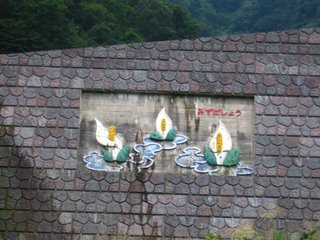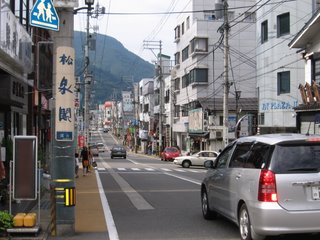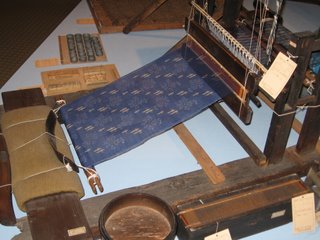Return to Yuzawa, part 2: Whatever Floats Your Boat
~Yet another week of insane teaching slips by. Yesterday, I managed to get the staff of my school a free trip to Tokyo Disney in the near future (more on that in a later post). Today brings the second of a three-post series on The Return to Yuzawa, which sounds like the title of an overblown adventure novel. Anyway, the Yuzawa museum held a few more interesting surprises:
 ^ An old saddle. I can just imagine a heavily-armored samurai riding a horse with this saddle, swinging his katana and screaming "Banzai!!!" Or perhaps it just belonged to a farmer. A katana-wielding farmer.
^ An old saddle. I can just imagine a heavily-armored samurai riding a horse with this saddle, swinging his katana and screaming "Banzai!!!" Or perhaps it just belonged to a farmer. A katana-wielding farmer.--One of my favorite exhibits consisted of two very old maps of Echigo-Yuzawa:
 ^ I was able to favorably compare this old map of Yuzawa with a modern map I got from the tourism office. It sure looks like the area was a lot less crowded when this map was made. I like how the mountains "wrap around" the perimeter of the map in an interesting cartographic technique. Or maybe I'm wrong, and the mountains really did reverse direction like that. Perhaps "Things were different back then"?
^ I was able to favorably compare this old map of Yuzawa with a modern map I got from the tourism office. It sure looks like the area was a lot less crowded when this map was made. I like how the mountains "wrap around" the perimeter of the map in an interesting cartographic technique. Or maybe I'm wrong, and the mountains really did reverse direction like that. Perhaps "Things were different back then"? ^ This seems to show a large Japanese house of some kind surrounded by fields. Looks like a nice place to live. I wish I was able to read the display tag, but it's mostly in complex kanji that I have yet to see, much less read.
^ This seems to show a large Japanese house of some kind surrounded by fields. Looks like a nice place to live. I wish I was able to read the display tag, but it's mostly in complex kanji that I have yet to see, much less read.--After departing the museum, I saw an amazing sight over the nearby mountains:
 ^ The heavy cloud bank in the upper-center has filled in the gap in the mountain with mist. It looks almost as if a wave of white water is slowly rolling over the mountains and will soon inundate the entire town! I want to hike to the summit of that mountain and walk among the clouds. Hmm, perhaps that last line was a bit too poetic...
^ The heavy cloud bank in the upper-center has filled in the gap in the mountain with mist. It looks almost as if a wave of white water is slowly rolling over the mountains and will soon inundate the entire town! I want to hike to the summit of that mountain and walk among the clouds. Hmm, perhaps that last line was a bit too poetic... ^ After leaving the museum, the next stop was a waterfall on the outskirts of town. The last time I was in here, this area was covered with snow, but now it's lush with green. On the way, I saw what was obviously a midget house (no disrespect intended to those of Restricted Growth).
^ After leaving the museum, the next stop was a waterfall on the outskirts of town. The last time I was in here, this area was covered with snow, but now it's lush with green. On the way, I saw what was obviously a midget house (no disrespect intended to those of Restricted Growth). ^ Yuzawa is such a beautiful place. There were a lot of butterflies and other strange insects wandering around near the flowers. I saw an adult Japanese man with an insect net running around trying to catch butterflies. Hey, whatever floats your boat.
^ Yuzawa is such a beautiful place. There were a lot of butterflies and other strange insects wandering around near the flowers. I saw an adult Japanese man with an insect net running around trying to catch butterflies. Hey, whatever floats your boat. ^ I took this picture while standing on the bridge in the previous picture. This area was carefully landscaped and quite pleasing to the eye. I want this stream in my backyard; the sound of falling water always helps me fall asleep.
^ I took this picture while standing on the bridge in the previous picture. This area was carefully landscaped and quite pleasing to the eye. I want this stream in my backyard; the sound of falling water always helps me fall asleep. ^ A closer picture of the nearby flowers. This was the first trip that I brought along a tripod, and I was quite pleased with the clarity of the pictures thanks to the newfound stability of my camera.
^ A closer picture of the nearby flowers. This was the first trip that I brought along a tripod, and I was quite pleased with the clarity of the pictures thanks to the newfound stability of my camera. ^ A view of the same area as above, but from the back. This was taken on the concrete path that led deeper into the woods. It's interesting to imagine what this place looks like under eight feet of snow (hint: white).
^ A view of the same area as above, but from the back. This was taken on the concrete path that led deeper into the woods. It's interesting to imagine what this place looks like under eight feet of snow (hint: white). ^ Proceeding down the path, I reached a small dam that you can see in the background from three pictures ago. Notice how the damp stone on either side of the water creates a 'rainbow' look. At first, I thought this was painted to look this way (I wouldn't put it past the Japanese!), but a closer inspection revealed that the colored streaks are simply mold of some kind. Nevertheless, it is quite beautiful from a distance, another one of those unintended natural miracles that make the world a brighter place.
^ Proceeding down the path, I reached a small dam that you can see in the background from three pictures ago. Notice how the damp stone on either side of the water creates a 'rainbow' look. At first, I thought this was painted to look this way (I wouldn't put it past the Japanese!), but a closer inspection revealed that the colored streaks are simply mold of some kind. Nevertheless, it is quite beautiful from a distance, another one of those unintended natural miracles that make the world a brighter place. ^ A picture cut/painted into the right side of the dam (you can see part of it on the right in the previous picture). The hiragana on the upper-right reads, "mizubashou", which is the name of a plant colloquially known as the "Banana plant" (Latin: Lysichiton camtschatcense). I assume they're native to the area, but I wasn't on the lookout for any at the time. Perhaps I'll spot some on my next trip to Yuzawa.
^ A picture cut/painted into the right side of the dam (you can see part of it on the right in the previous picture). The hiragana on the upper-right reads, "mizubashou", which is the name of a plant colloquially known as the "Banana plant" (Latin: Lysichiton camtschatcense). I assume they're native to the area, but I wasn't on the lookout for any at the time. Perhaps I'll spot some on my next trip to Yuzawa.  ^ On the bridge again, but aimed at a higher angle. Deeper back, beyond the dam, stretches a mysterious valley that was my target destination. Don't you just feel a thrill of excitement at seeing this picture? If you don't, you need to get off of your rear and go do something outdoors!
^ On the bridge again, but aimed at a higher angle. Deeper back, beyond the dam, stretches a mysterious valley that was my target destination. Don't you just feel a thrill of excitement at seeing this picture? If you don't, you need to get off of your rear and go do something outdoors!Who knows what lies deeper in this valley? Perhaps: a hidden shrine? Strange fellow travelers? Bizarre creatures never before beheld by mortal eyes (if mortal=David)? A mighty cataract of dihydrogen monoxide? Yes, all that and more in the next post of...The Return to Yuzawa! ~Oyasumi.


















